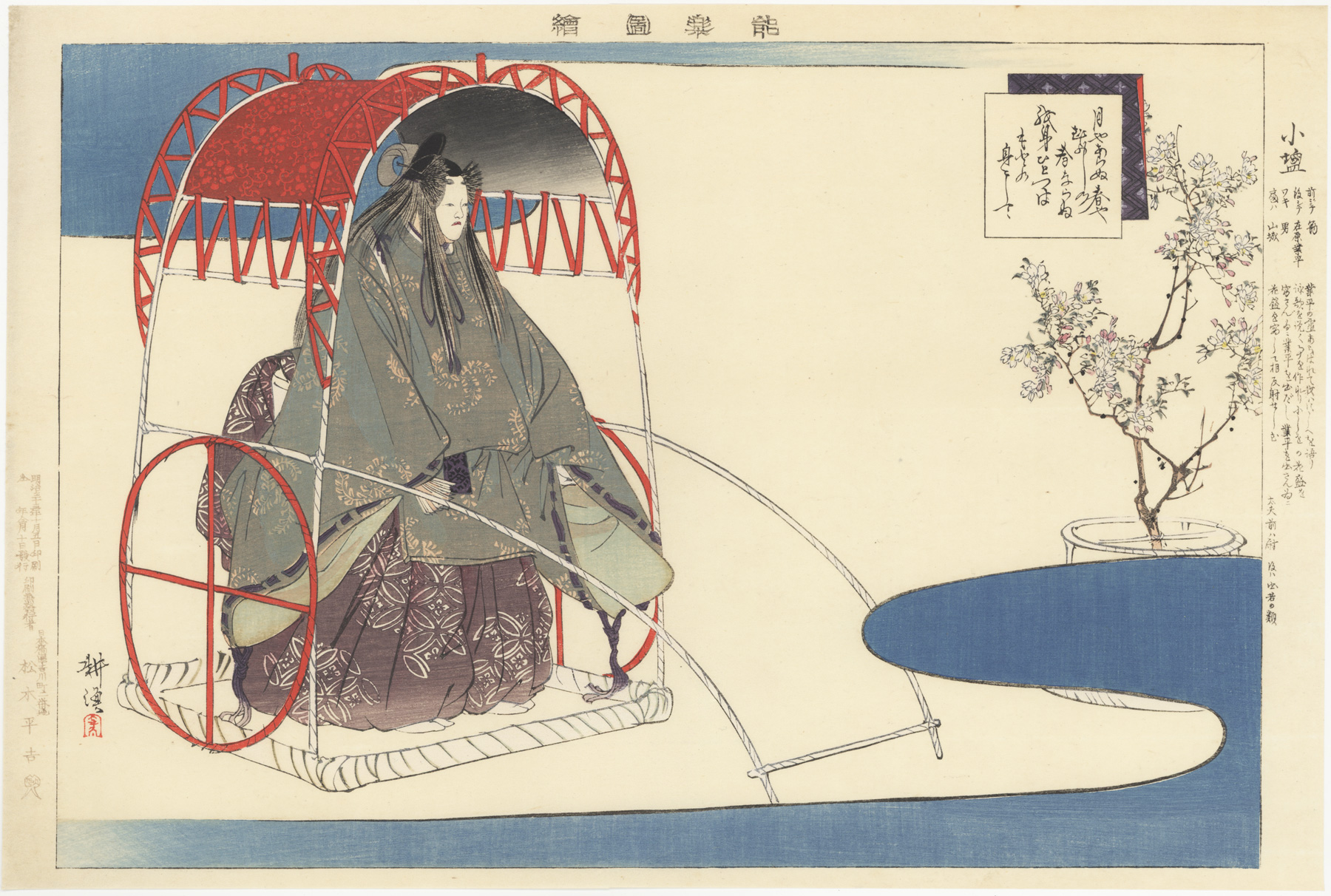About This Print
The Play - Oshio
A Mangoes with his Companions to Mt. Oshio having heard that the cherry blossoms arein full bloom there. Among the many flower viewers is an Old Man carrying abranch of blossoms. The Men speak with him and are impressed by his elegantexpression of appreciation for the blossoms. He quotes poems by Ariwara noNarihira (825-880) nobleman and courtier, in particular one relating to thevisit to the area by the Empress of the Second Ward, Fujiwara no Koshi, who wassecretly his lover for a time. The poem reads: Ohara ya, Oshio no yama mo, kyo koso wa, kamiyo no koto mo,Omoiizurame and is translated by Helen McCullough in Tales ofIse as: “On this auspicious day, the divinity of Mt. Oshio at Ohara, willsurely remember, what happened long ago, in the Age of the Gods.” The OldMan is, in fact, the spirit of the ‘Man of Old’, the poet Ariwara no Narihirain a transformed state. Later he appears in his true form in a blossomdecorated ox cart and dances, remembering incidents of the past and praisingthe beauty of the cherry blossoms.
Source: The Beauty of Silence: Nō and Nature Prints by Tsukioka Kōgyo (1869-1927), Robert Schaap & J. Thomas Rimer, Hotei Publishing, 2010, p. 81, cat. 26.
A man (waki) and his two companions (wakizure) view the famous cherry blossoms at Ōhara, also known as Oshio, a hill to the southwest of Kyoto. They meet an old man (shite), who is obviously a person of elegant taste. He tells them stories about the place and recites poems written by the famous Heian courtier Ariwara no Narihira when he visited the spot. In the second part of the play, the old man now reappears as Narihira, riding in a vehicle from which to view the flowers. He recites some of his poems, dances in the moonlight, and then vanishes at dawn.
In the print, Narihira stands in a flower-viewing vehicle and observes the cherry blossoms.
The square inset in the upper right-hand corner includes part of a famous waka poem on the vicissitudes of love written by Narihira, which the shite delivers:
Is not the moon the same?
The spring
Not the spring of old?
Only this body of mine
Is the same body...
Right Margin Detail (summary of play)
TranscriptionSource: Ritsumeikan Art Research Center
「業平の霊あらはれて我いにしへを語り 詠歌を説く事をを作れり 小しをか花盛を写さん為ニ業平を出だし 業平を出さん為ニ花盛を写して相反射せしむ太夫前は尉 後ハ★者の類」
Print Details
| IHL Catalog | #1645 |
| Title | Oshio 小塩 |
| Series | Nōgakuzue 能樂圖繪 (Illustrations of Noh) |
| Artist | Tsukioka Kōgyo (1869-1927) |
| Signature | Kōgyo 耕漁 (see image below) |
| Seal |  |
| Date |  Meiji 32nd year, 10th month, 5th day / Meiji 32nd year, 10th month, 10th day 明治三十二年十月五日印刷 仝年仝月十日発行 The ARC database entry for their print arcUP1010 carries the same dates as this collection's print Other impressions are listed with a date of Meiji 33, but this might be a misreading of the date. |
| Edition | unknown |
| Publisher |  |
| Carver | |
| Impression | excellent |
| Colors | excellent |
| Condition | excellent |
| Genre | ukiyo-e |
| Miscellaneous | |
| Format | oban yoko-e |
| H x W Paper | 9 1/2 x 14 1/4 in. (24.1 x 36.2 cm) |
| H x W Image | 8 7/8 x 13 in. (22.5 x 33 cm) area within printed black border |
| Collections This Print | University of Pittsburgh Special Collections 20091209-kogyo-0349; Scripps College Ruth Chandler Williamson Gallery 2009.7.13; Art Institute Chicago 1939.2258.163; Art Research Center, Ritsumeikan University AcNo.arcUP1010 CoGNo.arcUP0840 AlGNo.arcUP0840 |
| Reference Literature | The Beauty of Silence: Nō and Nature Prints by Tsukioka Kōgyo (1869-1927), Robert Schaap & J. Thomas Rimer, Hotei Publishing, 2010, p. 81, cat. 26 |


